North Korea unveils apparent new ICBM in night time military parade

A mock-up of an apparently new solid-fueled intercontinental ballistic missile is displayed during a military parade to mark the 75th founding anniversary of North Korea’s army, at Kim Il Sung Square in Pyongyang on Wednesday.
North Korea has unveiled an apparently new solid-fueled intercontinental ballistic missile, photos released by state-run media showed Thursday, as leader Kim Jong Un doubles down on a pledge to build even more advanced missiles and nuclear bombs.
The display of apparent mock-ups of the powerful new missile — which would allow for more stealthy launches — came during a massive military parade marking the 75th anniversary of the North Korean army’s founding late Wednesday in Pyongyang’s Kim Il Sung Square.
The bulk of North Korea’s long-range ballistic missile arsenal consists of weapons that use liquid fuel, which requires them to be fueled up at launch sites — a time-consuming process that leaves them open to pre-emptive strikes. Solid-fueled ICBMs, however, would not need to be fueled up, making them easier to deploy quickly and more difficult to spot and shoot down.
Analysts said images released by the official Korean Central News Agency (KCNA) showed at least five transporter-erector launchers carrying large missile canisters for the solid-fueled ICBMs, though the actual missiles were not displayed.
The pictures also showed Kim, sporting a fedora and black coat in a style akin to his grandfather — the country’s founder — surrounded by military leaders, attending the event with his “beloved daughter,” believed to be named Ju Ae, and his wife, Ri Sol Ju.
The parade featured at least 11 of North Korea’s “monster” Hwasong-17 ICBMs, for a total of some 16 long-range missiles — the most ever displayed in a single parade.
North Korean leader Kim Jong Un, along with his wife, Ri Sol Ju, and their daughter, believed to be named Kim Ju Ae, (seated at the back) attend a military parade to mark the 75th founding anniversary of North Korea’s army, at Kim Il Sung Square in Pyongyang on Wednesday. | KCNA / VIA REUTERS
Japan’s Defense Ministry has estimated that the Hwasong-17, believed to be the world’s largest road-mobile liquid-fueled missile, is capable of traveling more than 15,000 kilometers (9,320 miles), depending on the weight of the warhead it is carrying. Such a range would put a large chunk of the globe within striking distance.
“The columns of ICBMs appeared … with the enthusiastic cheers of the people full of pride and self-confidence, demonstrating the … development of the military capability and tremendous nuclear strike capability of the DPRK,” KCNA reported, using the acronym for the North’s formal name, the Democratic People’s Republic of Korea.
“Nuke for nuke and an all-out-confrontation for an all-out-confrontation!” it added, noting that the North’s “strategic missile units” were prepared to fulfill their mission “anytime, true to the order of the leader only.”
Ankit Panda, a nuclear policy expert at the Carnegie Endowment for International Peace, said the display could prove worrying for the United States.
“This is cumulatively more ICBM launchers than we’ve ever seen before at a North Korean parade,” Panda wrote on Twitter.
He said that if each missile were tipped with multiple warheads — a capability sought by Kim — they could represent enough of a threat to overwhelm U.S. ballistic missile defenses.
KCNA said that “tactical nuclear units” also took part in the parade in a demonstration of its “powerful war deterrent and counterstrike ability.” Last October, the North trumpeted simulated strikes using tactical, or lower-yield, nuclear weapons intended for use on the battlefield.
Tensions over the North’s nuclear and missile programs soared in 2022 as it fired off a record number of weapons in the face of calls by the U.S. and its allies to return to denuclearization talks.
Although North Korea has yet to launch a missile this year, experts say 2023 could prove to be even more perilous, with signs already emerging that Kim remains determined to follow through on a 2021 pledge to build even more advanced missiles and nuclear bombs.
In a recent policy speech laying out his goals for the new year, Kim lambasted the “hostile forces” of the U.S., South Korea and Japan, pledging to oversee “an exponential increase” in the country’s nuclear arsenal, including the mass-production of tactical weapons.
Troops take part in a military parade in Pyongyang on Wednesday. | KCNA / VIA REUTERS
Kim’s remarks have effectively left denuclearization talks dead in the water as Washington, Seoul and Tokyo beef up their deterrent capabilities and sanctions enforcement in response.
“The regime has staked its legitimacy on nuclear weapons at the expense of diplomacy and the economy,” said Leif-Eric Easley, a professor at Ewha University in Seoul.
Although Kim has been known to deliver fiery speeches at military parades, this time he let North Korea’s expanding tactical and long-range missile forces “speak for themselves,” Easley said.
In December, North Korea tested a “first-of-its-kind” high-thrust solid-fuel engine that appeared aimed at developing a new solid-fuel ICBM. A test of the actual solid-fuel long-range weapon could happen soon, as could a long-anticipated seventh nuclear test, possibly one involving a tactical weapon.
“Military parades largely serve to justify Kim’s policies to a domestic political audience,” Easley said. “The message Pyongyang wants to send internationally, demonstrating its capabilities to deter and coerce, will likely come in the form of solid-fuel missile tests and detonation of a miniaturized nuclear device.”



